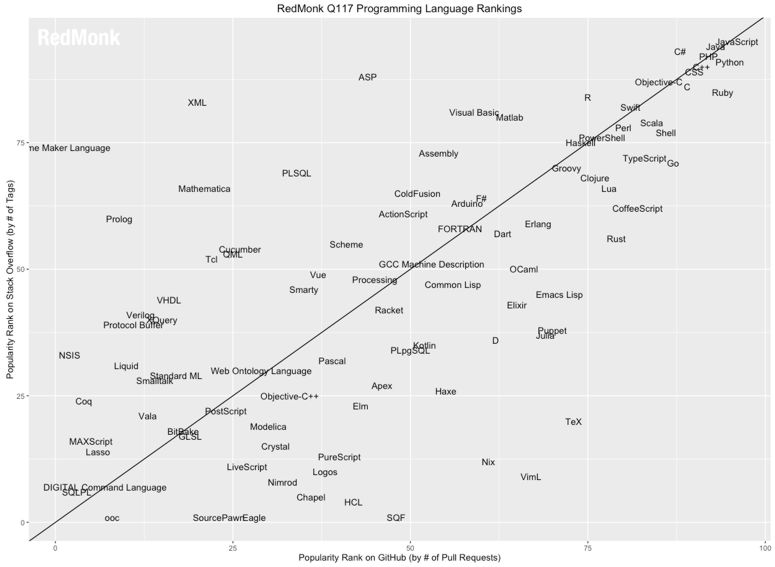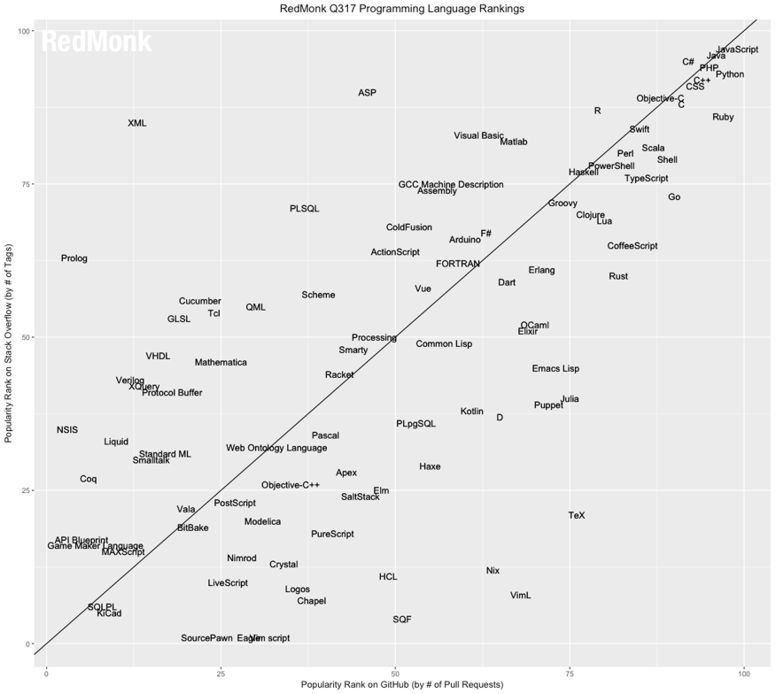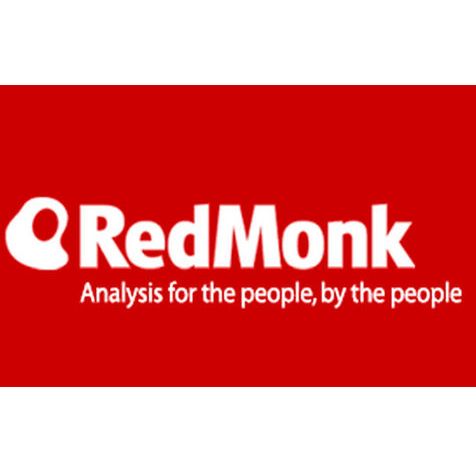| RedMonk Rankings Reveal The Languages We Love |
| Written by Janet Swift | |||
| Thursday, 15 June 2017 | |||
|
RedMonk has published the latest of its twice yearly language rankings. There is very little change from January, and looking back over previous iterations it is remarkable how stable the rankings of the top languages have been. RedMonk "inherited" the methodology for its language rankings. The very first chart of this type, see below, came from Dataists and was created by Drew Conway and John Myles White. As we reported at the time they collected data on the number of Stack Overflow questions that were tagged with the name of a language and on the number of projects using the language in Github. They found that the two were correlated at the 0.8 level.
While the analysis didn't rank languages, the chart shows noted that the most popular were C#, Java, Javascript, Python, PHP, C, Objective C, C++, Perl and Ruby and Shell (scripts). The Dataists did note some interesting outliers such as VimL which was the 10th most popular language on Github, but had almost no questions on StackOverflow? They commented: Is the StackOverflow measure actually picking up the opaqueness of languages rather than the size of their community? That might explain the position of R.
RedMonk first repeated the Dataists analysis in September 2011 using the R script written by Conway and identified the same languages as being Tier 1 languages. Stephen O'Grady, author not only of the initial RedMonk report, but all the subsequent ones commented that the results passed his: pass my basic sniff test. There are a few mild surprises – Erlang and D are a bit lower than I expected, Go slightly higher – but there are no glaring errors to my eye. If this is the reliably the case, we will have gained an important tool in the triage that inevitably results from runtime fragmentation coverage. After this RedMonk settled into a twice yearly pattern with reports in January and June. Since January 2014, when GitHub retired its own rankings for language popularity, on which it had formerly relied, RedMonk queries the GitHub archive for its data and presents its own Top 20 ranking. When we reported the results of the January 2015 iteration our headline was Top Languages 2015 - Stasis But For Go And Swift. What is interesting is that the very same Tier 1 languages from the first exercise in 2010 were in the top 12 but had been joined by CSS in 8th place. O'Grady had to tweak methodolgy again for January 2017 chart (having to base GitHub data on pull requests) but despite changes, reported that: the results were generally correlated with our past runs.
The Tier 1 language that had "dropped out" was Perl which ranked in 15th place, together with Go. Scala and Swift had overtaken it and were tied in 11th place with Shell. But as you can see from the chart they don't really form part of the top cluster, which is reduced to a gang of 10.
Six months on and the latest chart is very similar - which is something RedMonk is pleased about stating: Following the update to our process entering 2017, what we most wanted to see in a subsequent run was stability. Because programming language adoption is a lagging indicator typically assessed by counting metrics, wild fluctuations are likely to be false indicators and over-responsive to actual market shifts which tend to be slower. In this, we were rewarded, because this quarter’s rankings show the expected modest amounts of change.
RedMonk prefaced its observations on this graph with: it’s necessary to observe once again the remarkable staying power of JavaScript and Java atop the rankings. The former has lead the rankings as long as we’ve been doing them, and Java has never been lower than two. Rounding out the Top 5 are Python, PHP and C# which have at times traded places but are all languages with massive volume behind them. None of these languages moved in this ranking, but one tied for fifth did slip. This is a reference to C++ which has dropped to 6th and O'Grady comments: It will be interesting to watch its trajectory, however, to see if the focus on systems languages with modern features such as Go begins to erodes any of this traction or if the language’s raw speed will continue to sustain a high level ranking. He also singles out Ruby: Of the Tier 1 languages, Ruby has demonstrated perhaps the most movement in our history of ranking languages. Debuting at #5, it peaked at #4 in Q313 and fell to #6, bounced back to #5 and has since been steadily drifting downwards. This quarter’s ranking of #8 is the lowest for Ruby to date Scala also comes in for comment. Having been was down to #14 a year ago, it jumped three spots into a tie at #11 in January and has now slipped back to #12. But O'Grady notes: It may be facing its stiffest test yet in [Kotlin] which is inspired by Scala but has the advantage of now having a major front end driver for adoption to complement its back end relevance. Kotlin is currently at #46, and normally wouldn't attract attention but O'Grady explains why it now it has been chosen as an offical language for Android it merits being watched: When Google chooses one to be a fully supported language on the most popular mobile platform in the world, however, we make exceptions. Kotlin’s numbers in our rankings are interesting, if premature. We snapshot data as of the first of June, which means Kotlin had exactly fifteen days to profit from its new role as Google’s alternative to Swift. That produced a bump from its last quarterly ranking, if a small one: in January, Kotlin was at #50, so it jumped a mere four spots, which on the surface seems unimpressive. Two things are interesting about the Kotlin numbers, however. First, the jump it made to get to #50. Kotlin spent the 2016 calendar year way down at #65 on our rankings; all of a sudden in January, it jumped 15 spots to #50. O'Grady makes the assumption that this jump was do do with an early unannounced interest in the language. He concludes: Kotlin’s already moving, but our January rankings should be fascinating to watch for Android’s new first tier language alone.
More InformationThe RedMonk Programming Language Rankings: June 2017 Revisiting the Dataists Programming Language Rankings
Related ArticlesRedmonk Language Rankings January 2017 Top Languages 2015 - Stasis But For Go And Swift Kotlin - New Language For Android
To be informed about new articles on I Programmer, sign up for our weekly newsletter, subscribe to the RSS feed and follow us on Twitter, Facebook or Linkedin.
Comments
or email your comment to: comments@i-programmer.info |
|||
| Last Updated ( Wednesday, 05 August 2020 ) |






